
Argyresthia is a genus of moths in the family Argyresthiidae, previously treated as subfamily Argyresthiinae in the family Yponomeutidae.

Scythropia crataegella, the hawthorn moth, is a species of moth in the monotypic genus Scythropia. It is found in western Eurasia.

Argyresthia goedartella, the bronze alder moth, is a species of moth of the family Argyresthiidae.

Argyresthia pygmaeella is a moth of the family Yponomeutidae. The species was first described by Michael Denis and Ignaz Schiffermüller in 1775 from a specimen found near Vienna, Austria
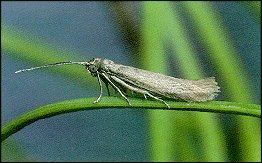
Coleophora laricella, the western larch case-bearer, is a moth belonging to the family of case-bearing moths Coleophoridae. It is native to Central and Northern Europe, with its original food source being the European larch or Larix decidua. However, it was introduced to North America in the mid-19th century where it has gained a wide range and become an invasive defoliater of several species of the genus Larix, particularly the western larch Larix occidentalis and the tamarack larch Larix laricina.
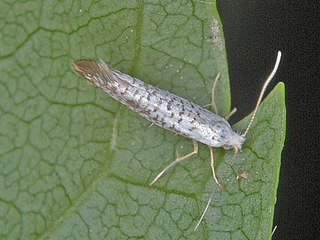
Argyresthia retinella is a species of moth of the family Yponomeutidae.

Abagrotis alternata, the greater red dart or mottled gray cutworm, is a moth of the family Noctuidae. The species was first described by Augustus Radcliffe Grote in 1865. It is found in eastern North America, from New Brunswick west across southern Canada to western Alberta, south to Arizona, New Mexico and the Gulf of Mexico.
Xestia normaniana, or Norman's dart, is a moth of the family Noctuidae. The species was first described by Augustus Radcliffe Grote in 1874. It is found in North America from Nova Scotia across southern and central Canada to Alberta. In the eastern United States it ranges from Maine to eastern Minnesota, and south along the Appalachians to western North Carolina. It has recently been recorded from Tennessee.

Melitara dentata, the North American cactus moth, is a moth of the family Pyralidae. The species was first described by Augustus Radcliffe Grote in 1876. It is native to western North America, where it is widespread from Alberta to southern Arizona and central Texas. It is an introduced species in Hawaii.
Gazoryctra roseicaput is a moth of the family Hepialidae. It was described by Berthold Neumoegen and Harrison Gray Dyar Jr. in 1893. It is known from the mountains of western North America, including Washington, Oregon, British Columbia and Alberta.
Argyresthia abies is a moth of the family Yponomeutidae first described by Hugh Avery Freeman in 1972. It is found in the Canadian provinces of Alberta, Saskatchewan and northern Ontario.

Argyresthia oreasella, the cherry shoot borer moth, is a moth of the family Yponomeutidae. It is found in North America, including New York, Michigan, Idaho, Missouri, Colorado, New Mexico, California, Quebec, Alberta and Saskatchewan.
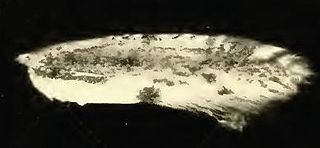
Argyresthia belangerella is a moth of the family Argyresthiidae first described by Vactor Tousey Chambers in 1877. It is found in Canada. It might be only a variety of Argyresthia conjugella.
Argyresthia calliphanes is a moth of the family Yponomeutidae first described by Edward Meyrick in 1913. It is found in Canada from Ontario to British Columbia and possibly in Alberta, Saskatchewan and Manitoba. In the United States, it ranges from New York to California.
Argyresthia columbia is a moth of the family Yponomeutidae first described by Thomas Nesbitt Freeman in 1972. It is found in Canada in south-eastern British Columbia and is possibly also present in Alberta.
Argyresthia flexilis is a moth of the family Yponomeutidae first described by Hugh Avery Freeman in 1960. It is found in the United States in northern Montana and probably the adjacent parts of Canada.
Argyresthia mariana, the graybanded leafroller, is a moth of the family Yponomeutidae. The species was first described by Thomas Nesbitt Freeman in 1972. It is found in Canada in northern Ontario and possibly Alberta.
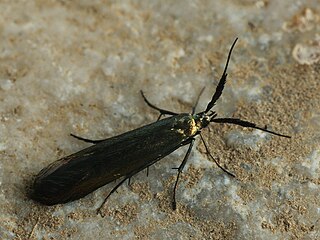
Friederike Lienig was an entomologist from the Russian Empire who also resided in the Kingdom of Prussia. Four species of tiny moths are named after her. One is Cosmopterix lienigiella. At first self taught she was later instructed by Philipp Christoph Zeller at the technical high school in Meseritz. She was a Member of the Stettin Entomological Society.
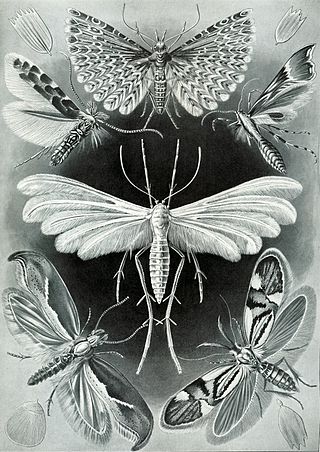
Annette Frances Braun was an American entomologist and leading authority on microlepidoptera, a grouping of mostly small and nocturnal moths. Her special interest was leaf miners: moths whose larvae live and feed from within a leaf.











